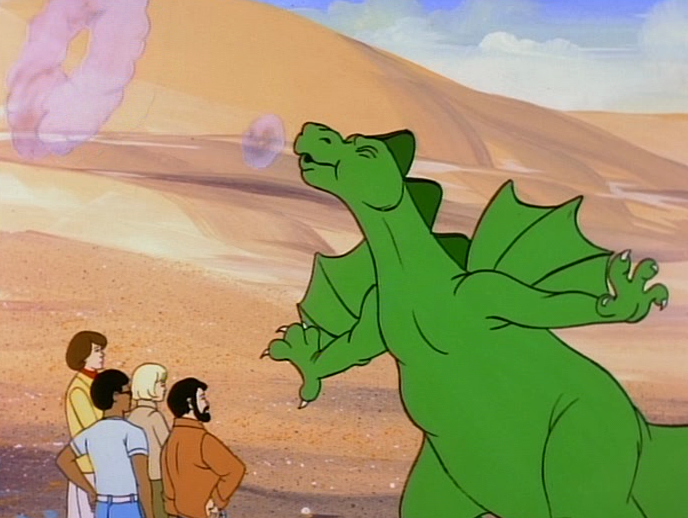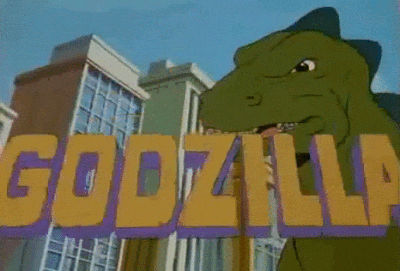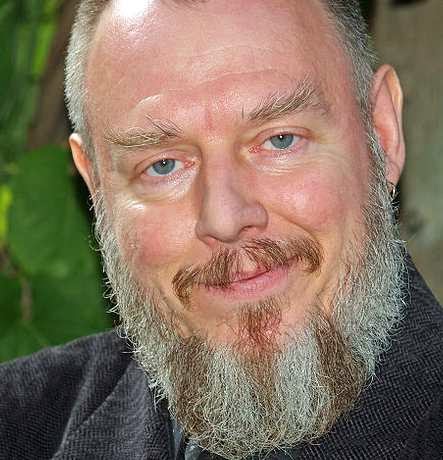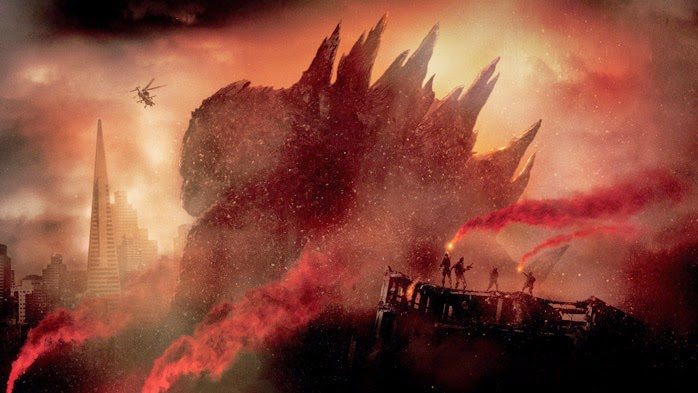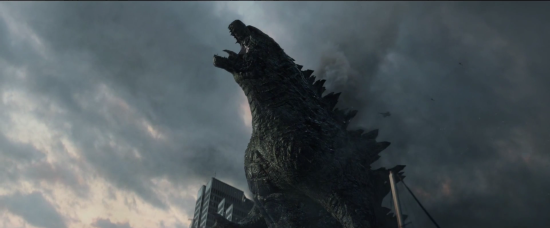By
PETER H. GILMORE
Godzilla achieved his 60th anniversary this past November and his name is known around the globe. Over the course of 30 films he has gone from the dark, lumbering embodiment of the hydrogen bomb to being a child-friendly defender of the Earth, even if he can’t help leveling a city or two in the process. How you relate to him often depends upon which film initiated you into the fandom of the King of the Monsters.
In 1954, Toho was inspired by the recent re-release of the 1933 KING KONG as well as the previous year’s
THE BEAST FROM 20,000 FATHOMS by Ray Harryhausen to want to enter into the profitable world of oversized animals raising havoc. But the Japanese filmmakers had a more serious premise since their own nation had been shattered by two nuclear bombs dropped on them by the United States’ militia. The horror of those ultimate weapons could safely be expressed through the allegory of a vast, prehistoric creature roused to punish mankind, whose nuclear detonations had disturbed this great beast. He was called Gojira, supposedly a combination of the Japanese words for gorilla (gorira) and whale (kujira).
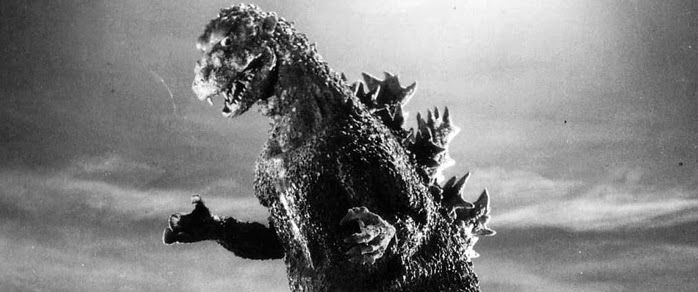 |
| GOJIRA, 1954. |
When this film was adapted for the US market with some of its message diluted and Raymond Burr added, his name was transliterated as
Godzilla, bringing in almost a sense of blasphemy with the reference to the divine for such a hideous creature. And, to the best of their abilities, director Ishiro Honda and SPFX genius Eiji Tsuburaya conjured forth a dark terror who arose from Tokyo Bay to incinerate that city, irradiating the survivors who would later perish from this nuclear poisoning. Their use of a man in a suit as well as puppets worked well to embody a design meant to be a combination of T-Rex, Stegosaurus and Iguanodon.
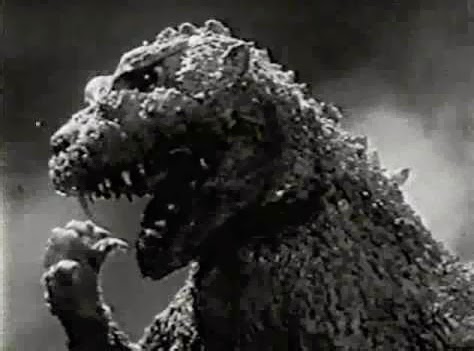 |
| The Gojira puppet. |
The film was a box office success, leading to a sequel less than a year later wherein Godzilla fought with a giant form of ankylosaur named Anguirus. The rubber suits in this are cruder and made slimmer so that the actors could wrestle, unlike the original suit in which the actor could barely walk. This set the pattern of monster vs. monster that persisted for all but two subsequent films. Seven years later, stimulated by the success of the imported British giant monster film
GORGO, a third film was produced and Toho licensed RKO’s King Kong to battle their nuclear flame-throwing reptile. The original Kong was only about 50 feet tall, though his height tends to vary between 18 and 60 feet as he’s depicted. Gojira was sized at 50 meters tall (164 feet) for most of his films, so Toho simply bumped-up Kong so he’d be a worthy competitor. This film also took a turn towards the comic away from the horror-orientation of the first two. From now through the 15th film, Godzilla would become ever more child friendly, in both behavior and looks, as he fought invading space monsters brought to Earth by kitschy aliens. He thus went from a visage of terror, to a large-eyed cutesy monster that was cheered-on by children around the world until the end of this first “Showa” series in 1975.
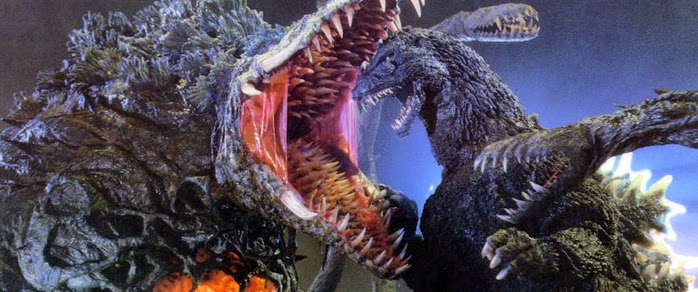 |
| GODZILLA VS. BIOLLANTE, 1989. |
In 1984, THE RETURN OF GODZILLA revived the character as a serious threat to our species in a film meant as a commentary on the US and Soviet obsession with expanding nuclear arsenals. This incarnation was again fierce and frightening and now 80 meters tall. In 1989,
GODZILLA VS. BIOLLANTE critiqued genetic engineering and had Godzilla in combat with a peculiar creature that came from the fusion of Godzilla’s cells with the DNA of a rose along with the spirit of the deceased daughter of the scientist who made this horror. Godzilla’s look and size (100 meters) became stabilized for this second “Heisei” series in the following 6 films, with mostly minor tweaks. He fought revised versions of old adversaries: Mothra (with her evil cousin Battra), the golden dragon King Ghidorah, and a robotic replica Mechagodzilla There were two additional new foes: Space Godzilla—who had crystal protruding from his shoulders and as a dorsal array, and Destoroyah—a multi-formed aggregate conflation of a prehistoric crustacean with elements of the Oxygen Destroyer weapon that dissolved Godzilla in his very first film. In this 1995 film came the most dramatic change as Godzilla had suffered from a hyper-dose of radiation causing his internal nuclear organs to go haywire, threatening either a vast explosion or meltdown, both on a scale that would decimate the planet. Fiery red patches, lit from within, cover his body and he seems to be in constant agony. He does at last melt-down, poisoning Tokyo after the humans had assisted in vanquishing his enemy. A younger Godzilla co-starred, and after being slaughtered by Destoroyah, he is revived by the excess radiation, absorbed to bring forth a resurrected Godzilla.
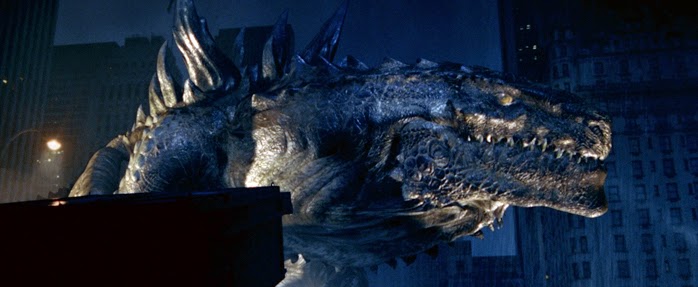 |
| GODZILLA, 1998. |
The US took a crack at a Godzilla film in 1998 under Roland Emmerich and Dean Devlin. Though Patrick Tatopoulos designed for them a detailed, slim, 60 meter tall saurian monster influenced by then current ideas about prehistoric animals, their script had it running away from the military and later laying eggs which hatched into raptor-like young in Madison Square Garden. This monster didn’t even have the usual nuclear fire breath. Both this beast, later called Zilla by Toho, and its young were dispatched by missiles fired by US jets. All other Godzillas found such weaponry to be but a minor inconvenience. Despite doing well financially, the only sequel was a cartoon series broadcast on Saturday mornings for American television. Many young people thus were first exposed to this creature as being Godzilla. Thankfully the creature in this—the sole-survivor of the egg clutch who imprinted on the biologist from the film as a daddy figure—mostly behaved far more like Godzilla, fighting an array of giant monsters both new and at times reminiscent of Toho favorites. And he did have his fire-breath back.
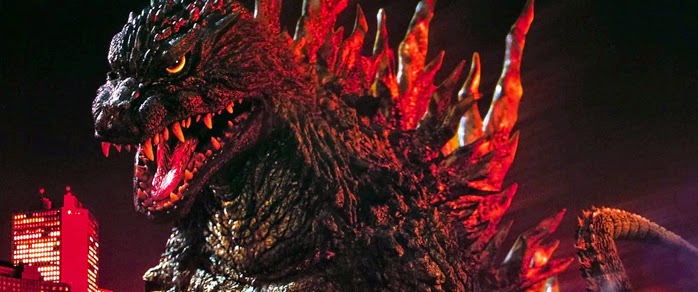
 |
| GODZILLA: FINAL WARS, 2004. |
In 2000, Toho launched a new film to bring attention back to their creation and for the first time made Godzilla green—with huge, spikey magenta back plates. He was returned to his original height, which allowed for more detailed miniature structures to be his playthings.
GODZILLA 2000 had this new, fiercer manifestation fight another alien intruder, Orga, who looked a bit like the Rancor from RETURN OF THE JEDI. This look lasted for two films, then when Shusuke Kaneko came on board in 2001 he gave Godzilla a supernatural twist—he was filled with the angry souls of those who died in WW2 in the Pacific theatre of combat. This 60 meter Godzilla had blank white eyes and his look went back to the original film, as did his charcoal gray body color. His rage helped him exterminate several of his old enemies (Baragon, Mothra, King Ghidorah) now cast as guardians of the land. The next two films centered around Godzilla battling another version of Mechagodzilla, called Kiryu, who was constructed around the bones of the original Godzilla. His look was a toned-down version of the 2000 design, though properly tinted in gray tones. The final film of this series (
GODZILLA: FINAL WARS, from 2004) was a campy return to the 70s movies with references to The Matrix films, as tacky alien invaders control the many monsters of Earth to obliterate humanity. Here, a very athletic Godzilla is freed from a glacial prison to dispatch the other monsters and again save the planet.
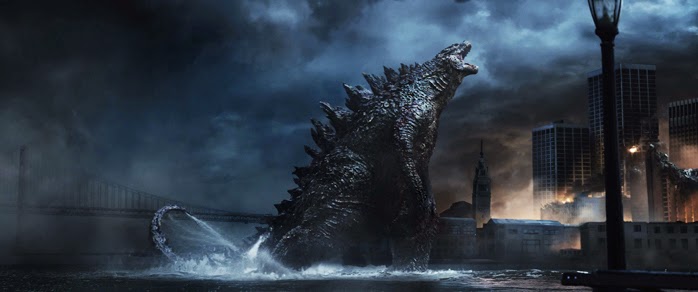 |
| GODZILLA, 2014. |
Ten years later LEGENDARY PICTURES revived the dormant series under director Gareth Edwards with
GODZILLA (2014), wherein a design wrought according to biological principles had the largest Godzilla of all at 106 meters. His body has a bear-like heft with a face that combines ursine and aquiline aspects. The state of the art CGI brought him to breathing, slavering, roaring life as he fought the MUTOs, a bonded pair of fellow prehistoric, radiation-hungry creatures with bizarre anatomy. These creatures have stapler-remover shaped jaws, clustered sense organs instead of eyes, and strangely configured multiple hooked limbs, the male having one pair of wings. Here Godzilla is defined as the last survivor of a prehistoric radiation devouring species who was the apex predator of his ancient ecosystem. When humans inadvertently cause the revival of a parasitic species from his time, Godzilla rises from his home in the abyssal trenches to right nature’s balance by eliminating the MUTOs. He is not yet mankind’s adversary, but woe unto us should he take notice of our upsetting the balance of his planet. This film made over a half-billion dollars in its theatrical run, pleasing both LEGENDARY and Toho as well as most fans of the entire series. With its sequel set to be released in 2018, Toho has decided to keep the interest going by promising us the beginning of their fourth series to be premiered in 2016 to the global market.
That stalwart Godzilla is alive and well at 60 with two series to be in progress simultaneously. He’s once again come ‘round to sounding the cautionary tone that made
GOJIRA (1954) so effective. His new face looks upon us with a stern visage meant as a warning that we must be in harmony, rather than conflict, with nature. I suspect this always timely concept will keep Godzilla as a vital archetype for many decades to come.
Magus Gilmore has represented the Church of Satan since “The Satanic Panic” of the 1980s, being interviewed on numerous television and radio programs dealing with the topic of Satanism, including appearances on The History Channel, BBC, The Sci-Fi Channel, Point of Inquiry, and Bob Larson’s Christian radio show. His audio, video, and print interviews are numerous and continue to grow, making him the most interviewed Satanist in history. In 2001 he was appointed High Priest of the Church of Satan by Magistra Blanche Barton. Gilmore studied music composition at New York University where he earned B.S. and M.A. degrees. His solo album Threnody for Humanity presents orchestral-styled electronic music composed and performed by Gilmore. His book The Satanic Scriptures was published in 2007 and is currently available in a number of translations.
